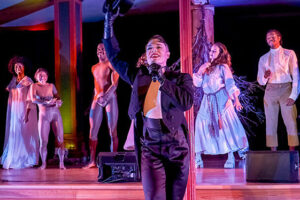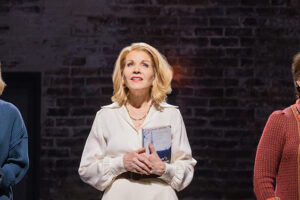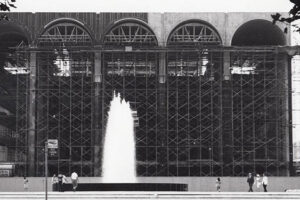

Many were surprised when Beethoven’s masterpiece (performed with minimal German dialogue) was announced as part of this year’s Bel Canto at Caramoor series which tends to focus on works by Donizetti, Rossini and Bellini (next summer’s centerpiece will be Il Pirata starring Angela Meade on July 8) conducted by Will Crutchfield. I suspect Fidelio may have been chosen because Pablo Heras-Casado, the music director of the Orchestra of St. Luke’s—the festival’s resident band, wanted to conduct it.
If so, it’s ironic then that Heras-Casado’s frequently perverse and superficial reading was the afternoon’s weakest feature. His insistence on waiting for applause after every number was particularly annoying, especially following the Pizarro-Rocco duet which effectively diluted the usually overwhelming start of “Abscheulicher.”
After a swift and exciting overture, one imagined that the Spanish conductor would relax but he raced through both the opening duet and Marzelline’s aria. The sublime canon-quartet which followed proved exceptionally slow but that expansive movement was atypical. The march was breathless, while Heras-Casado’s tempo for Pizarro’s aria challenged mightily both the baritone and the male chorus. Happily he was more considerate toward his prima donna accompanying her with care and sensitivity. Unfortunately an unsubtle and overloud Prisoners’ Chorus evoked little of the hushed wonder one expects at this special moment.
The prelude to Florestan’s aria was grandly dramatic but its hectic climax stressed its overextended tenor. The conductor’s breakneck pace for the always breathtaking “Er sterbe” quartet again pushed his singers to their limits—that excessive haste continued into the finale whose bustling opening measures had the undersized chorus nearly gasping for breath. While I’m not a fan of the near-universally acclaimed Otto Klemperer recording of Fidelio, finding it for the most part slow and oppressively ponderous, Heras-Casado’s seeming quest for visceral excitement went far too far in the opposite direction robbing this most humane opera of its touching depth.
Throughout the afternoon I frequently overheard the oft-repeated objection that the opera begins weakly and fails to gain momentum until Pizarro’s entrance. But I’ve always found the opening singspiel-like numbers set in Rocco’s household exceptionally engaging and dramatically important in establishing that Fidelio’s world is not one of superheroes but of simple if occasionally extraordinary human beings yearning to live in a world of honor and truth.
Unfortunately the two opening numbers went for little as Andrew Owens’ small-voiced Jacquino was aggressively overshadowed by Georgia Jarman’s harshly charmless Marzelline (jarringly clad is a clingy hot pink gown). Well remembered from the Met’s last revival in 2006, Kristinn Sigmundsson’s complex Rocco handsomely delineated the jailer’s increasingly conflicted nature: earnestly proclaiming the immense importance of money, yet refusing to murder the prisoner under his charge. If the Icelandic bass’s voice now lacks the imposing roundness of tone of some of the famous Roccos of the past, it still rang out with pleasing authority.
Alfred Walker bit into Pizarro’s thundering music with genuinely frightening fire; however, at tunes one wished that his healthy bass-baritone might have been a bit bigger and cut through Heras-Casado’s unforgiving orchestra more pungently. Young baritone Xiaomen Zhang sang pleasantly but lacked the stature and authority one expects from Don Fernando.
The last time I heard Paul Groves he sounded under considerable strain as The Painter at the premiere last fall of the new William Kentridge production of Berg’s Lulu at the Met. Sadly that seems to have not been an unusual occasion as his surprisingly pugnacious Florestan struggled throughout with the part’s high tessitura. His once-lovely Mozart tenor has gotten bigger and darker while retaining some of its former beauty, yet the climaxes of both his aria and the “O namenlose freude!” duet with Leonore were especially painful. The sterling van den Heever deserved a more worthy husband.
The Met hasn’t programmed Beethoven’s opera for the past decade presumably because it couldn’t cast the demanding title role, but Canadian soprano Adrianne Pieczonka will finally come to the company’s rescue next spring. But one wonders how she will compare to van den Heever, whose wide-ranging and plush dark soprano rang out sensationally, tiring only a bit toward the end. Hers was an intriguingly introverted Leonore, one who even in a semi-staged performance rarely gestured keeping her riveting intensity very inward.
Often one perceives a Leonore cautiously husbanding her energies until after “Abscheulicher,” but not the bold van den Heever—she easily soared over the quartet and the oft-derided but delicious trio with Rocco and Marzelline. Her fierce, nervous duets with Rocco demonstrated a touching chemistry with Sigmundsson. For me the ultimate test of a Leonore is her triumphant cry of “Töt erst sein Weib!” in the dungeon scene and van den Heever’s B-flat sailed out splendidly momentarily quelling the chaos—it was too bad Walker failed to brandish a dagger nor van den Heever a pistol.
After two seasons of watching van den Heever twitch and totter about as David McVicar’s eccentric Elisabetta in Donizetti’s Maria Stuarda at the Met, it was exceptionally gratifying to witness deeper, more complex aspects of her artistry. Her Elettra in Idomeneo at the Met next season immediately becomes a must-see, and one wonders what sort of Norma she might be upcoming in Toronto and Dallas.
But clearly the Met need look no further for its next Leonore; van den Heever has the potential to become a great Leonore—she’s already a very very good one. But let’s pray it doesn’t take that house another decade to schedule our chance to experience it.
Photo: Dario Acosta























Comments